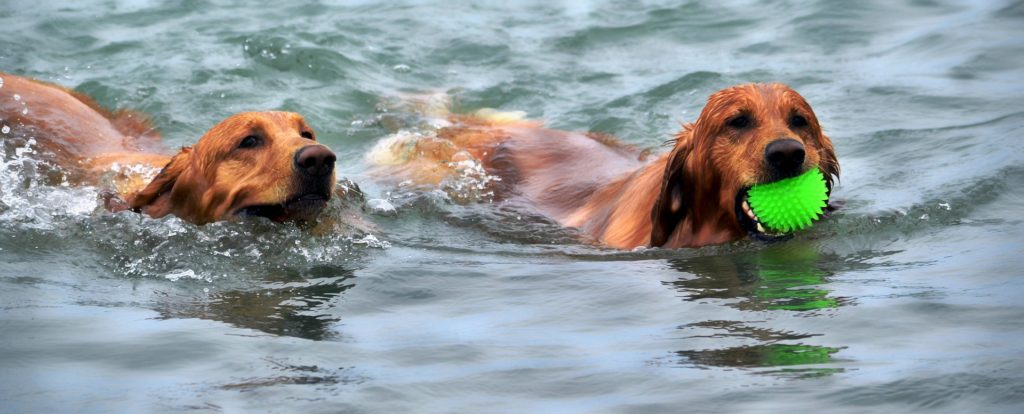How To Teach A Dog To Swim
Richard Whately, 19th century Oxford academic and Bishop of Durham, taught his dogs to climb trees on the banks of the river Cherwell, and jump into the water from the branches.

Fortunately, there are much easier ways of getting your pet dog used to taking a dip. But the key word in the previous paragraph is ‘taught’. Dogs are not born swimmers – they need teaching to a certain extent, even though most of them can stay afloat and doggy-paddle their way back to shore if you throw them in. But this is certainly not a recommended way to introduce pooch to the pond!
Many of them need no persuasion at all, and jump into rivers, ponds and the sea at every opportunity. Others are less eager to take the plunge, and some breeds are simply not built for the doggy paddle.
Sorting the Water-Dogs from the Non-Swimmers
Dog breeds with no snout, such as the Boxer, English bulldog, French bulldog, Pekingese and Pug, have great difficulties keeping their noses above the water. Their squashed muzzles – ‘brachycephalic’ is the proper term – means they are simply not built for swimming. Similarly, breeds with large heads and muscular upper bodies such as American bulldogs and Staffordshire bull terriers are not able to swim well, or at all.
Dogs with short legs find it hard to get very far in the water, even though they are capable of holding their heads above the surface. This applies to such breeds as the Basset hound and Dachshund.
Taking the First Dip
For dogs that can swim in theory but are a bit nervous, or simply not yet used to taking a dip, there are a few tips and tricks that should turn them into water dogs in no time.
- Choose a location with water shallow enough for you to easily rescue the dog if it starts to panic. Somewhere with a slope is ideal – a lakeside, a gentle river, or a coastal pool. A paddling pool at home is where many dogs take their first swim.
- Try to choose a quiet location, to minimise distractions and enable the dog to concentrate on the swimming lesson.
- Keep the dog on a long lead during these early dips.
- Take a stick or toy to tempt your dog into the water. If you go in first, the dog will be more inclined to follow. Some will leap in at once, others need more time to get used to the idea. Never drag, throw or otherwise force a dog into water.
- Doggy lifejackets can be bought, if your pet is particularly nervous, or if you’re not sure whether he will be able to swim very well, based on his body shape.
- Once the dog is used to being in the water, wade further out (tricky in a paddling pool!) and encourage him to follow you. It’s all about building confidence.
- To help a nervous dog get used to having its feet off the bottom of the pool or river, hold him by the middle for reassurance. Paddling with the front paws will be instinctive, and you can encourage use of the back legs by raising the dog’s back end slightly. He will instinctively kick his hind legs to regain equilibrium.
- Once the dog is paddling at the front and kicking at the back, he’s cracked it. You can now let him test his new skill – but stay close and be prepared to hold him by the middle again, in case he tires or suddenly panics.
- It’s a good idea to take a towel to dry the dog once it’s emerged from the water. Smaller ones in particular can get cold very quickly. Be prepared for a gentle soaking as your wet pet shakes the water from its coat!
For many dogs, the so-called training process will be over in a couple of seconds. Many hounds swim as naturally as they woof – breeds such as Newfoundlands, Poodles, Otterhounds, the various Retrievers, Spaniels, Setters, and – surprise surprise – Portuguese and Spanish Water Dogs, for example.
And rest assured – you don’t need to teach them to climb trees as well!
This entry was posted in Dogs